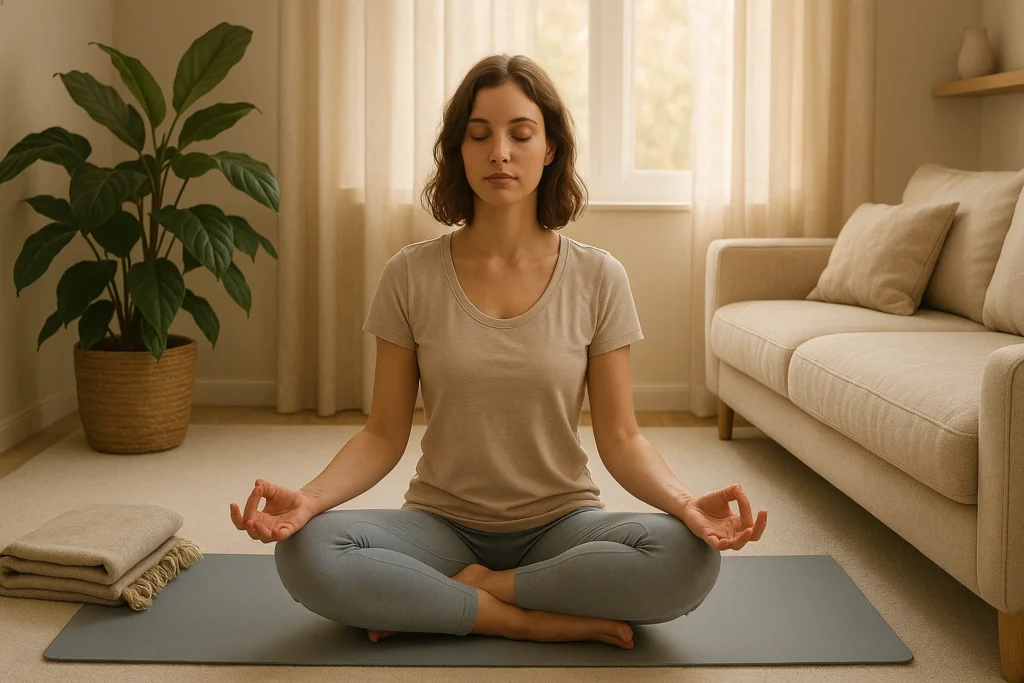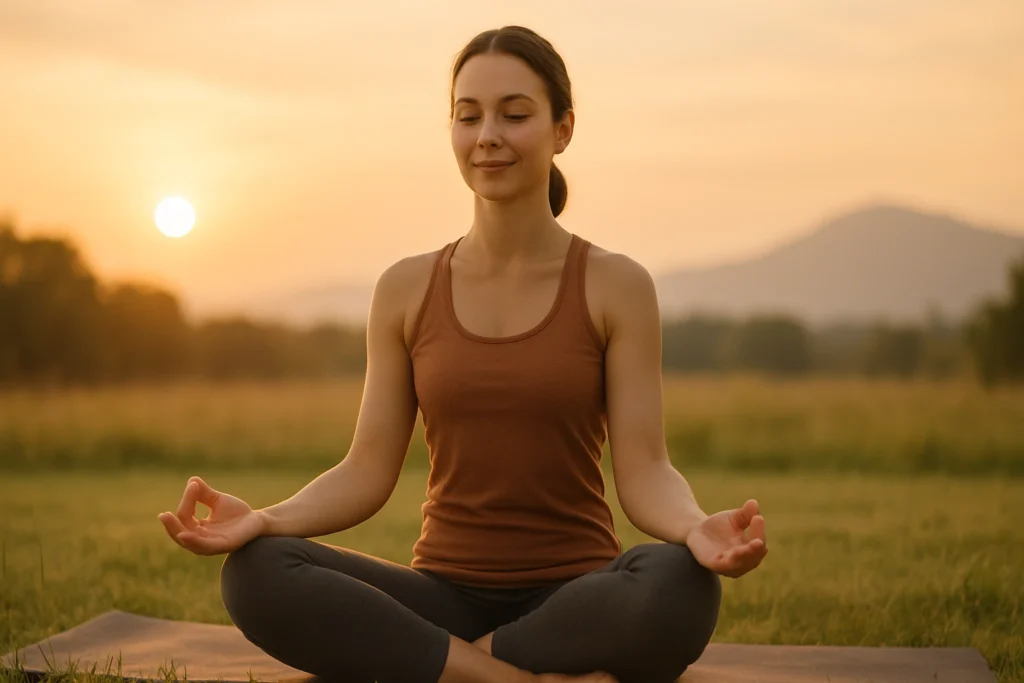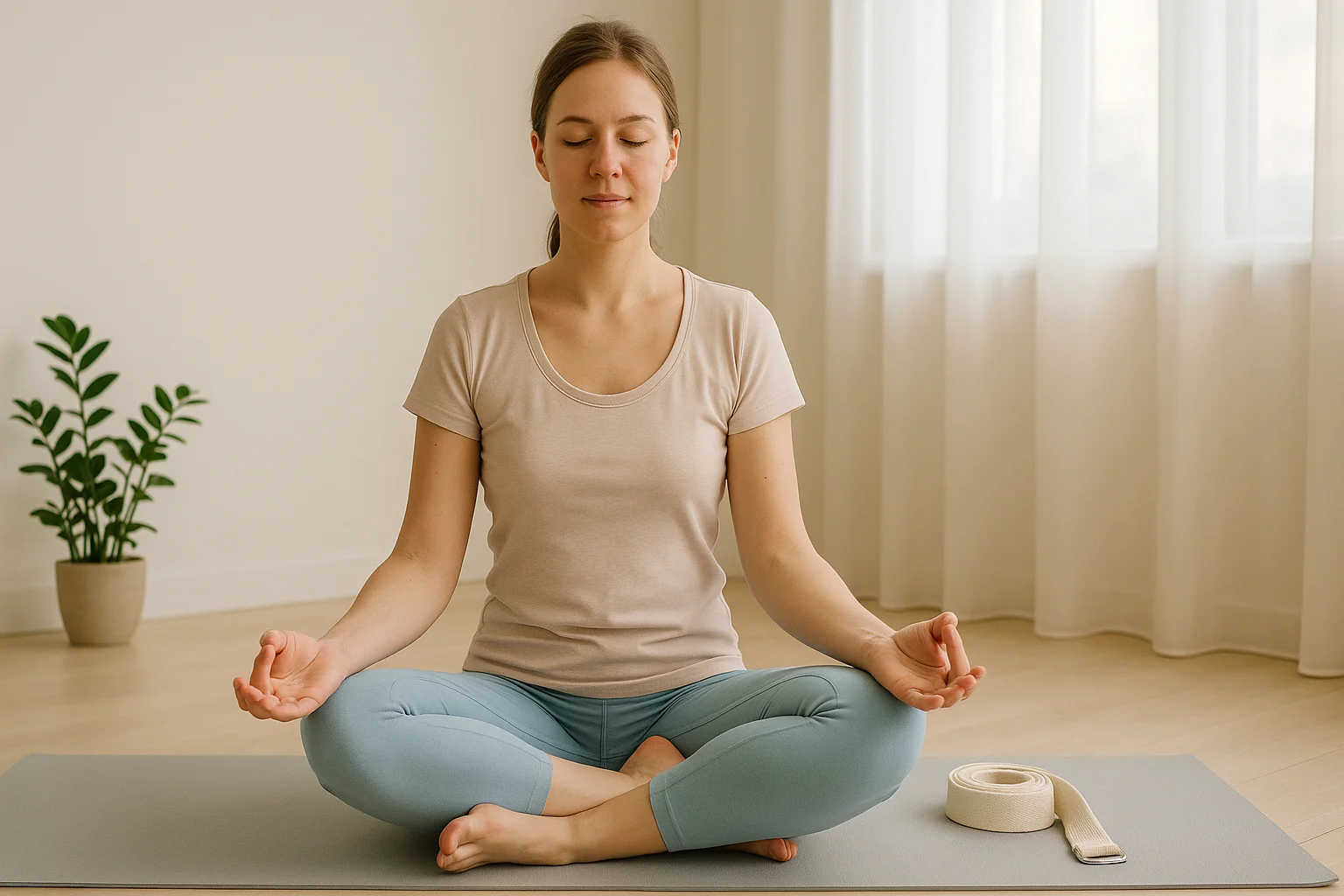
Struggling to touch your toes in your first yoga class? A yoga strap for beginners is a helpful tool to build flexibility and confidence at your own pace.
When I first tried yoga, touching my toes felt like chasing a distant star—frustrating and impossible. Sound familiar? A strap supported my practice, turning wobbly stretches into steady progress. This simple tool acts like your personal yoga sidekick, helping you reach further, align better, and feel more confident. So, let’s dive in and get started. ✨ For a complete overview of must-have props and accessories, check out our yoga gear guide.
This page contains paid/affiliate links. As an Amazon Associate we earn from qualifying purchases, and we may earn commissions from other partners—at no extra cost to you. Links marked with ‘#ad’ are affiliate links, meaning we may earn a commission at no extra cost to you. Learn more.
Table of Contents
- Why New Yogis Love Yoga Straps
- How a Strap Helps Beginners
- Choosing a First Yoga Strap
- Yoga Strap for Beginners: Core Techniques
- Strap-Assisted Exercises for Beginners
- Smart Tips for First-Time Yoga Strap Users
- Common Strap Mistakes Beginners Make
- Your 4-Week Yoga Strap Plan
- Frequently Asked Questions About Yoga Straps for Beginners
- Your Path to Confident Yoga
Why New Yogis Love Yoga Straps
- Gently Build Flexibility: A strap lets you slip into poses comfortably, making progress feel within reach.
- Improve Alignment and Posture: It’s like a gentle guide, helping your body find positions that support safety and a solid foundation.
- Feel Steady and Confident: The strap’s support may help you hold poses a bit longer, giving you that “I’ve got this!” vibe.
- Versatile & Affordable: Use it for countless poses, from seated stretches to standing balances—perfect for any new yogi.
- Listen to Your Body: Use the strap gently, never pushing into pain. Yoga is about connection, not competition.
Why a Yoga Strap Helps Beginners 🌱
Imagine reaching for something just out of reach—your fingers are so close, but not quite there. That’s where a yoga strap guide comes in, acting like a bridge to help you get where you want to go.
For beginners, this simple fabric belt is a game-changer:
- Boosts Flexibility: Got tight hamstrings or hips? The strap can help you stretch a bit further without forcing it, encouraging a long spine in poses like forward folds. For targeted stretches, explore our yoga hamstring stretches.
- Supports Alignment: Good alignment helps you move safely, and the strap can help you keep your spine long while teaching your body helpful mechanics.
- Adds Stability: In balancing poses, the strap gives you a secure grip, so you can focus on your breath instead of wobbling.
- Builds Strength: Pulling against the strap can help engage muscles and build strength gradually.
- May Help Prevent Strain: By easing you into poses, the strap may help reduce the risk of overstretching.
“A yoga strap isn’t just a crutch; it’s a bridge to what your body can do, safely and effectively.”
Many beginners feel discouraged if they can’t master poses right away. With a yoga strap, yoga becomes more accessible and less intimidating, like having a patient teacher by your side.
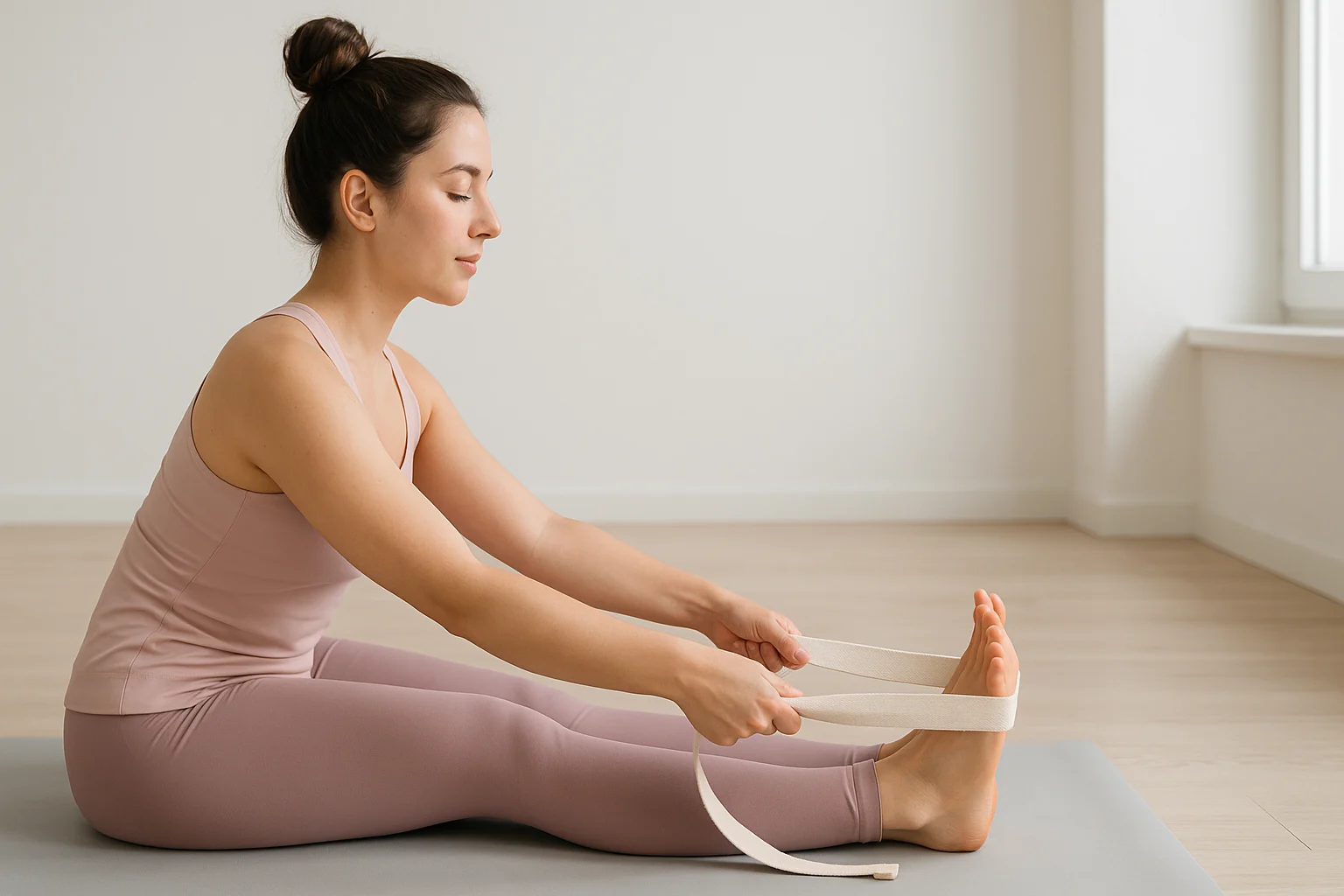
Choosing the Best Yoga Strap for Beginners 🧵
Before diving into poses, let’s pick the perfect yoga strap. Here’s what to consider:
Strap Length
Straps come in various lengths, and the right one depends on your needs:
| Strap Length | Best For | Notes |
|---|---|---|
| 6 feet (1.8 meters) | Shorter individuals, simple stretches, arm binds | Good for basic poses but may feel limiting. |
| 8 feet (2.4 meters) | Most beginners, average height, versatile use | Recommended for its flexibility in most poses. |
| 10 feet (3 meters) | Taller individuals, tight muscles, advanced poses | Great for extra reach but can be cumbersome. |
For most new yogis, an 8-foot strap is ideal, offering enough length without excess.
Product: Manduka Align Yoga Strap — 8 ft — soft cotton feel with a secure buckle for steady, beginner-friendly loops.
Tip: Pair the 8 ft length with a long spine in folds so you reach comfortably without rounding.
Material
Most yoga straps are cotton or polyester:
- Cotton: Soft, grippy, and comfortable. Ideal for beginners due to its non-slip texture.
- Polyester/Nylon: Durable but smoother, potentially less grippy.
Opt for cotton for your beginner yoga strap, as it’s gentle on the skin and secure. For sweaty practices, consider pairing it with a non-slip yoga mat for added stability.
Buckle Type
The buckle ensures secure loops:
- D-Ring Buckle: Easy to use, reliable, and common. Thread the strap through for a secure hold.
- Quick-Release Buckle: Less common, can be less secure for prolonged holds.
A D-ring buckle is often a simple, reliable choice. For taller folks, a 10-foot strap may work better. Choose cotton for comfort and D-rings for secure loops—versatility is key! For more tips on using straps, check out Yoga for All Humans’ guide to yoga strap stretches.
Yoga Strap for Beginners: Core Techniques 🛠️
Let’s master the basics of using a yoga strap as a beginner. These techniques create the foundation for many beginner-friendly yoga strap moves you’ll explore later in the article.
Basic Grips — Yoga Strap Guide
- Overhand Grip: Palms down, ideal for pulling actions.
- Underhand Grip: Palms up, great for shoulder stretches.
- Loop Grip: Thread through D-rings for a secure loop around feet or hands.
Product: Syntus Yoga Block and Yoga Strap Set — simple one-click starter kit for safer alignment while you learn the grips.
Tip: Use the blocks to lift your seat in folds so your strap work stays long-spined and comfortable.
Creating a Loop
- Thread one end through both D-rings.
- Thread it back through the first D-ring.
- Pull taut to secure. Practice until it feels natural!
Yoga Strap for Beginners: Strap Yoga Exercises 🪜
Ready to give it a try? Let’s go through a few beginner-friendly strap-assisted stretches you can start practicing today. These moves gently target common tight areas — like your hamstrings and shoulders — while keeping your body safe and supported.
1. Seated Forward Fold (Paschimottanasana) 🧘♀️
Why You’ll Love It: This pose is a gem for loosening tight hamstrings, stretching your spine, and calming your mind with every breath.
How the Strap Helps: It acts like an extra set of arms, helping you reach your feet without rounding your back, so you stay long and comfortable.
- Sit tall with your legs stretched out in front, toes pointing up like they’re reaching for the sky.
- Loop your yoga strap around the balls of your feet, holding it snugly.
- Grab it with both hands, arms relaxed but straight, and adjust for a gentle pull.
- Inhale deeply, lifting your chest to lengthen your spine.
- Exhale and hinge forward from your hips, keeping your back nice and long.
- Gently use the strap to guide your chest toward your legs without forcing.
- If your hamstrings feel tight, bend your knees slightly to stay comfy.
- Breathe deeply for 5–10 breaths, then ease back up slowly.
2. Bound Angle Pose (Baddha Konasana) 🦋
Why You’ll Love It: This pose opens your hips and stretches your inner thighs, leaving you feeling relaxed and grounded.
How the Strap Helps: It keeps you sitting tall and supports your hips as they gently open, like a butterfly spreading its wings.
- Start with your legs stretched out, then bring the soles of your feet together, letting your knees fall open.
- Loop the strap around your feet and lower back, pulling it snug to create a cozy loop.
- Sit up tall, grounding your sitting bones into the mat.
- Let your knees drift toward the floor gently—don’t push them!
- Relax into the stretch for 5–10 breaths, letting your thighs soften.
- When you’re ready, release the strap, stretch your legs out, and give them a little wiggle.
3. Extended Hand-to-Big-Toe Pose (Utthita Hasta Padangusthasana) 🦵
Why it helps: Builds leg strength, steadies your balance, and gives the hamstrings a friendly stretch.
Strap support: A loop around the foot lets you hold comfortably without overreaching.
- Stand tall in Mountain Pose, feet hip-width apart, feeling steady and grounded.
- Shift your weight to your left foot, then loop the strap around the ball of your right foot.
- Hold the strap with your right hand—or both hands if you need extra stability.
- Lift your right leg forward, keeping your left leg strong and rooted.
- Straighten your right leg as much as feels good, without rounding your back.
- Hold for 3–5 breaths, then gently lower and switch sides.
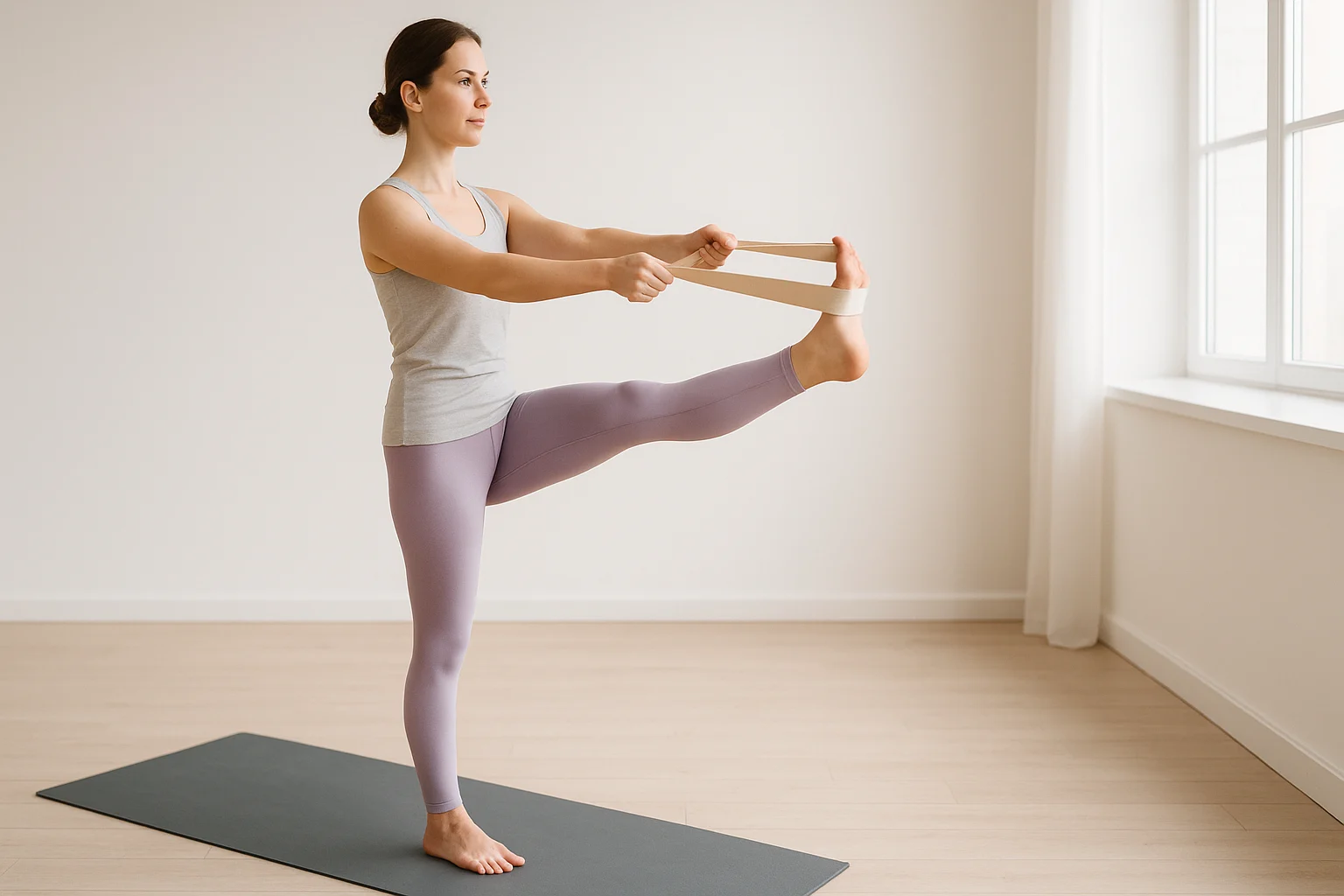
4. Reclined Hand-to-Big-Toe Pose (Supta Padangusthasana) 😴
Why it helps: A relaxing way to give your hamstrings a deep, soothing stretch.
Strap support: The loop lets you extend the leg comfortably without strain.
- Lie on your back with both legs stretched out, feeling relaxed.
- Bend your right knee toward your chest and loop the strap around the ball of your right foot.
- Hold the strap with both hands and extend your right leg toward the ceiling.
- Keep your left leg straight—or bend the knee slightly if your back feels tight.
- Gently pull the strap to deepen the stretch, keeping a tiny bend in your right knee for comfort.
- Relax into it for 5–10 breaths, then switch to the other side.
5. Cow Face Pose (Gomukhasana) Arms 🐄
Why it helps: Opens the shoulders, chest, and upper back so everything feels a bit freer.
Strap support: The belt bridges the gap between your hands so you can ease into the bind.
- Sit comfortably, either cross-legged or on your heels, whatever feels good.
- Hold the strap in your right hand, lift your arm up, then bend your elbow so the strap drapes down your back.
- Reach your left arm behind you, bend the elbow, and grab the strap with your left hand.
- Walk your hands toward each other along the strap, feeling a gentle stretch.
- Breathe deeply for 5–10 breaths, then switch sides.
Smart Tips for First-Time Yoga Strap Users ✨
- Be Patient: Flexibility grows over time. Celebrate small wins! 🎉
- Listen to Your Body: Use the strap for gentle stretches, not force.
- Breathe Deeply: Exhale to deepen stretches, inhale to lengthen.
- Start Slow: Master 1-2 poses before trying more.
- Experiment: Try the strap in other poses as you gain confidence—especially simple strap yoga exercises that target your shoulders and hamstrings.
Common Strap Mistakes Beginners Make 🛑
- Pulling Too Hard: Yanking the strap can strain muscles. Fix: Ease into stretches, aiming for a gentle release.
- Holding Your Breath: This tenses the body. Fix: Breathe deeply, exhaling to relax muscles.
- Rounding Your Back: Straining to reach can hurt your spine. Fix: Loosen the strap, bend knees, and hinge at your hips.
- Wrong Strap Length: Too short or long can hinder poses. Fix: Use an 8-foot strap for most beginners.
- Ignoring Pain: Sharp pain signals danger. Fix: Back off if you feel discomfort beyond a healthy stretch.
Your 4-Week Yoga Strap Plan 📅
Follow this simple plan to build confidence with your beginner yoga strap:
- Week 1: Practice Seated Forward Fold 3x/week, focusing on spine length.
- Week 2: Add Bound Angle Pose 2x/week to open hips.
- Week 3: Try Reclined Hand-to-Big-Toe Pose for deeper hamstring stretches.
- Week 4: Combine all poses, adding Cow Face Pose arms for shoulder mobility.
Track your progress below to stay motivated!
Your Yoga Strap Progress Tracker
Tap your current level to personalize your next step:
Select your progress to see your status!
Frequently Asked Questions About Yoga Straps for Beginners
Your Path to Confident Yoga 🌟
Remember, yoga isn’t about perfection — it’s about showing up and growing at your own pace. A strap can help you create space, build strength, and move with more confidence. Over time, you may find yourself using it less, though even experienced yogis still reach for a strap when they want a deeper stretch. So roll out your mat, grab your strap, and enjoy the journey — your body will thank you.
Cooling Roll-On for Post-Yoga Relief
After hamstring work and strap holds, a gentle, mess-free finish to your cool-down routine can feel soothing.
Explore the roll-on Partnered
No discount code needed — just click and explore.
Not medical advice; consult a healthcare professional for personal guidance.

